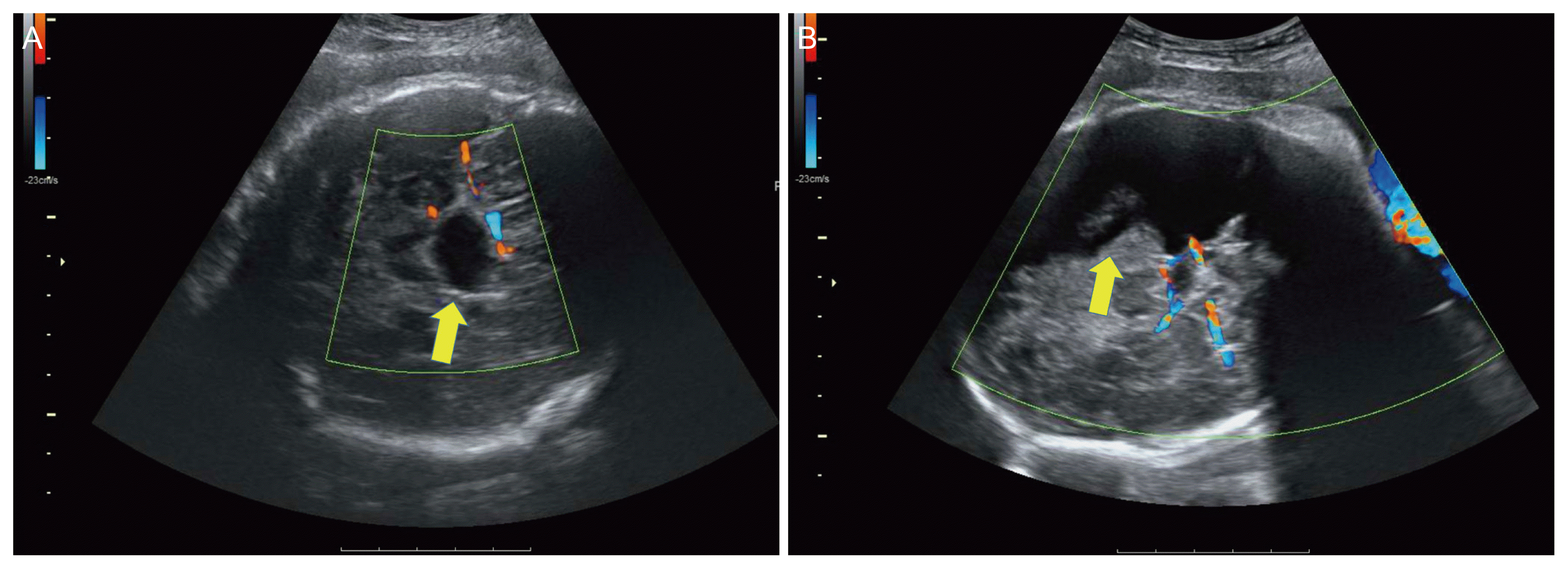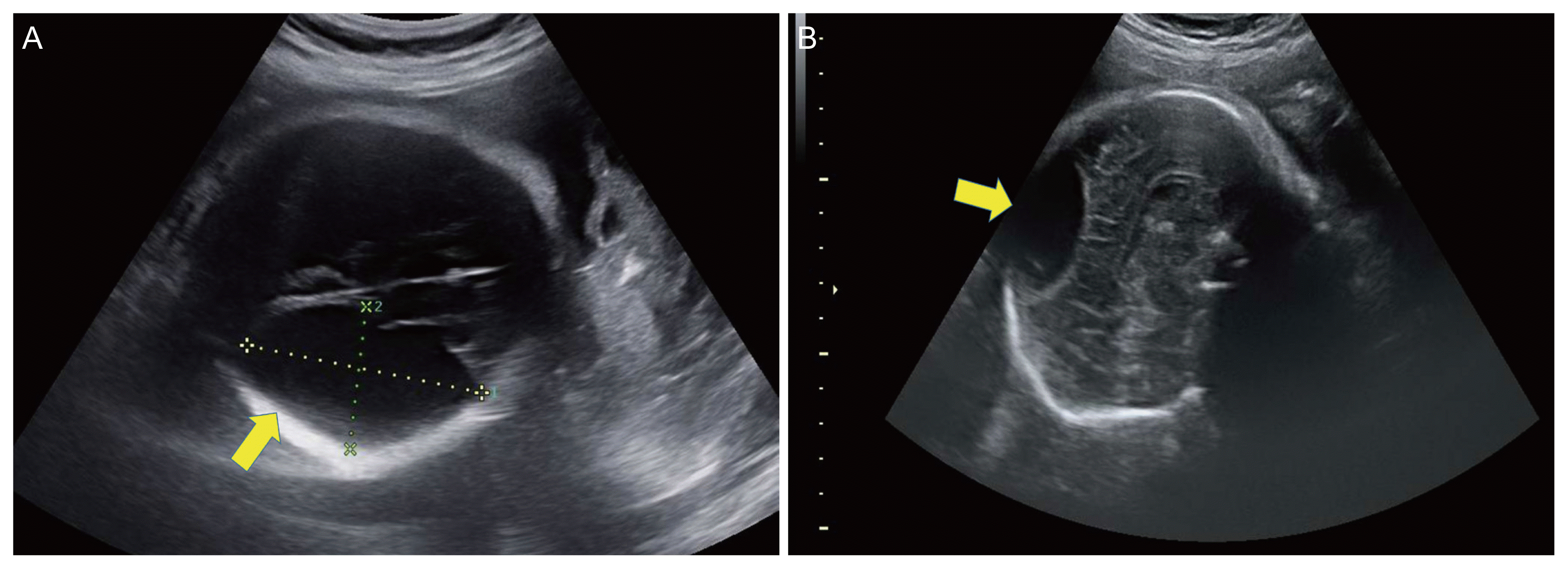1. Pappalardo EM, Militello M, Rapisarda G, Imbruglia L, Recupero S, Ermito S, et al. Fetal intracranial cysts: prenatal diagnosis and outcome. J Prenat Med. 2009; 3:28–30.
2. Robinson R. Congenital cysts of the brain: arachnoid malformations. Progress in neurological surgery. 4th ed. Basel: Karger Publishers;1971. p. 133–74.
3. Pascual-Castroviejo I, Roche MC, Martínez Bermejo A, Arcas J, García Blázquez M. Primary intracranial arachnoidal cysts. A study of 67 childhood cases. Childs Nerv Syst. 1991; 7:257–63.
4. De Keersmaecker B, Ramaekers P, Claus F, Witters I, Ortibus E, Naulaers G, et al. Outcome of 12 antenatally diagnosed fetal arachnoid cysts: case series and review of the literature. Eur J Paediatr Neurol. 2015; 19:114–21.
5. Chen CP. Prenatal diagnosis of arachnoid cysts. Taiwan J Obstet Gynecol. 2007; 46:187–98.
6. Youssef A, D’Antonio F, Khalil A, Papageorghiou AT, Ciardulli A, Lanzone A, et al. Outcome of fetuses with supratentorial extra-axial intracranial cysts: a systematic review. Fetal Diagn Ther. 2016; 40:1–12.
7. Hayward R. Postnatal management and outcome for fetal-diagnosed intra-cerebral cystic masses and tumours. Prenat Diagn. 2009; 29:396–401.
8. Yin L, Yang Z, Pan Q, Zhang J, Li X, Wang F, et al. Sonographic diagnosis and prognosis of fetal arachnoid cysts. J Clin Ultrasound. 2018; 46:96–102.
9. Rengachary SS, Watanabe I, Brackett CE. Pathogenesis of intracranial arachnoid cysts. Surg neurol. 1978; 9:139–44.
10. Catala M, Poirier J. Arachnoid cysts: histologic, embryologic and physiopathologic review. Rev Neurol (Paris). 1998; 154:489–501.
11. McLone DG. The subarachnoid space: a review. Pediatr Neurosurg. 1980; 6:113–30.
12. Gosalakkal JA. Intracranial arachnoid cysts in children: a review of pathogenesis, clinical features, and management. Pediatr neurol. 2002; 26:93–8.
13. Li L, Zhang Y, Li Y, Zhai X, Zhou Y, Liang P. The clinical classification and treatment of middle cranial fossa arachnoid cysts in children. Clin Neurol Neurosurg. 2013; 115:411–8.
14. Al-Holou WN, Yew AY, Boomsaad ZE, Garton HJ, Muraszko KM, Maher CO. Prevalence and natural history of arachnoid cysts in children. J Neurosurg Pediatr. 2010; 5:578–85.
15. Kim BS, Illes J, Kaplan RT, Reiss A, Atlas SW. Incidental findings on pediatric MR images of the brain. AJNR Am J Neuroradiol. 2002; 23:1674–7.
16. Grossman TB, Uribe-Cardenas R, Radwanski RE, Souweidane MM, Hoffman CE. Arachnoid cysts: using prenatal imaging and need for pediatric neurosurgical intervention to better understand their natural history and prognosis. J Matern Fetal Neonatal Med. 2022; 35:4728–33.
17. Yahal O, Katorza E, Zvi E, Berkenstadt M, Hoffman C, Achiron R, et al. Prenatal diagnosis of arachnoid cysts: MRI features and neurodevelopmental outcome. Eur J Radiol. 2019; 113:232–7.
18. Pierre-Kahn A, Hanlo P, Sonigo P, Parisot D, McConnell RS. The contribution of prenatal diagnosis to the understanding of malformative intracranial cysts: state of the art. Childs Nerv Syst. 2000; 16:619–26.
19. Pierre-Kahn A, Sonigo P. Malformative intracranial cysts: diagnosis and outcome. Childs Nerv Syst. 2003; 19:477–83.
20. Jeong SH, Lee MY, Kang OJ, Kim R, Chung JH, Won HS, et al. Perinatal outcome of fetuses with congenital high airway obstruction syndrome: a single-center experience. Obstet Gynecol Sci. 2021; 64:52–61.
21. We JS, Young L, Park IY, Shin JC, Im SA. Usefulness of additional fetal magnetic resonance imaging in the prenatal diagnosis of congenital abnormalities. Arch Gynecol Obstet. 2012; 286:1443–52.
22. Di Mascio D, Khalil A, Pilu G, Rizzo G, Caulo M, Liberati M, et al. Role of prenatal magnetic resonance imaging in fetuses with isolated severe ventriculomegaly at neurosonography: a multicenter study. Eur J Obstet Gynecol Reprod Biol. 2021; 267:105–10.
23. Wilson M, Muir K, Reddy D, Webster R, Kapoor C, Miller E. Prognostic accuracy of fetal MRI in predicting postnatal neurodevelopmental outcome. AJNR Am J Neuroradiol. 2020; 41:2146–54.
24. Diogo MC, Glatter S, Prayer D, Gruber GM, Bettelheim D, Weber M, et al. Improved neurodevelopmental prognostication in isolated corpus callosal agenesis: fetal magnetic resonance imaging-based scoring system. Ultrasound Obstet Gynecol. 2021; 58:34–41.
25. Hubbard AM, Harty P. Prenatal magnetic resonance imaging of fetal anomalies. Semin Roentgenol. 1999; 34:41–7.
26. Pilu G, Falco P, Perolo A, Sandri F, Cocchi G, Ancora G, et al. Differential diagnosis and outcome of fetal intracranial hypoechoic lesions: report of 21 cases. Ultrasound Obstet Gynecol. 1997; 9:229–36.
27. Abergel A, Lacalm A, Massoud M, Massardier J, des Portes V, Guibaud L. Expanding porencephalic cysts: prenatal imaging and differential diagnosis. Fetal Diagn Ther. 2017; 41:226–33.
28. Robles LA, Paez JM, Ayala D, Boleaga-Duran B. Intracranial glioependymal (neuroglial) cysts: a systematic review. Acta Neurochir (Wien). 2018; 160:1439–49.
29. Halabuda A, Klasa L, Kwiatkowski S, Wyrobek L, Milczarek O, Gergont A. Schizencephaly-diagnostics and clinical dilemmas. Childs Nerv Syst. 2015; 31:551–6.
30. Chen CP, Chang TY, Wang W. Third-trimester ultrasound evaluation of arachnoid cysts. Taiwan J Obstet Gynecol. 2007; 46:427–8.
31. Adiego B, Martínez-Ten P, Bermejo C, Estévez M, Recio Rodriguez M, Illescas T. Fetal intracranial hemorrhage. Prenatal diagnosis and postnatal outcomes. J Matern Fetal Neonatal Med. 2019; 32:21–30.
32. Beresford C, Hall S, Smedley A, Mathad N, Waters R, Chakraborty A, et al. Prenatal diagnosis of arachnoid cysts: a case series and systematic review. Childs Nerv Syst. 2020; 36:729–41.
33. André A, Zérah M, Roujeau T, Brunelle F, Blauwblomme T, Puget S, et al. Suprasellar arachnoid cysts: toward a new simple classification based on prognosis and treatment modality. Neurosurgery. 2016; 78:370–9. discussion 379–80.
34. Martínez-Lage JF, Pérez-Espejo MA, Almagro MJ, López-Guerrero AL. Hydrocephalus and arachnoid cysts. Childs Nerv Syst. 2011; 27:1643–52.
35. Erşahin Y, Kesikçi H, Rüksen M, Aydin C, Mutluer S. Endoscopic treatment of suprasellar arachnoid cysts. Childs Nerv Syst. 2008; 24:1013–20.
36. Mankotia DS, Sardana H, Sinha S, Sharma BS, Suri A, Borkar SA, et al. Pediatric interhemispheric arachnoid cyst: an institutional experience. J Pediatr Neurosci. 2016; 11:29–34.
37. Griebel ML, Williams JP, Russell SS, Spence GT, Glasier CM. Clinical and developmental findings in children with giant interhemispheric cysts and dysgenesis of the corpus callosum. Pediatr Neurol. 1995; 13:119–24.
38. Souter VL, Glass IA, Chapman DB, Raff ML, Parisi MA, Opheim KE, et al. Multiple fetal anomalies associated with subtle subtelomeric chromosomal rearrangements. Ultrasound Obstet Gynecol. 2003; 21:609–15.
39. Hogge WA, Schnatterly P, Ferguson JE 2nd. Early prenatal diagnosis of an infratentorial arachnoid cyst: association with an unbalanced translocation. Prenat Diagn. 1995; 15:186–8.
40. Chen CP, Su YN, Weng SL, Tsai FJ, Chen CY, Liu YP, et al. Rapid aneuploidy diagnosis of trisomy 18 by array comparative genomic hybridization using uncultured amniocytes in a pregnancy with fetal arachnoid cyst detected in late second trimester. Taiwan J Obstet Gynecol. 2012; 51:481–4.
41. Furey CG, Timberlake AT, Nelson-Williams C, Duran D, Li P, Jackson EM, et al. Xp22.2 chromosomal duplication in familial intracranial arachnoid cyst. JAMA Neurol. 2017; 74:1503–4.
42. Bayrakli F, Okten AI, Kartal U, Menekse G, Guzel A, Oztoprak I, et al. Intracranial arachnoid cyst family with autosomal recessive trait mapped to chromosome 6q22.31–23.2. Acta Neurochir (Wien). 2012; 154:1287–92.
43. Li K, Kong DS, Zhang J, Wang XS, Ye X, Zhao YL. Association between ELP4 rs986527 polymorphism and the occurrence and development of intracranial arachnoid cyst. Brain Behav. 2019; 9:e01480.
44. Chalouhi GE, Marangoni M, Zerah M, Ville Y. P09.24: intrauterine treatment of a suprasellar inter-hemispheric arachnoid cyst by feto-cisternoscopy. Ultrasound Obstet Gynecol. 2012; 40:210.
45. Society for Maternal-Fetal Medicine (SMFM), Monteagudo A, Kuller JA, Craigo S, Fox NS, Norton ME, et al. SMFM fetal anomalies consult series #3: intracranial anomalies. Am J Obstet Gynecol. 2020; 223:B2–50.
46. Society for Maternal-Fetal Medicine (SMFM), Yeaton-Massey A, Monteagudo A. Intracranial cysts. Am J Obstet Gynecol. 2020; 223:B42–6.
47. Bannister CM, Russell SA, Rimmer S, Mowle DH. Fetal arachnoid cysts: their site, progress, prognosis and differential diagnosis. Eur J Pediatr Surg. 1999; 9(Suppl 1):27–8.
48. Adilay U, Guclu B, Tiryaki M, Hicdonmez T. Spontaneous resolution of a sylvian arachnoid cyst in a child: a case report. Pediatr Neurosurg. 2017; 52:343–5.
49. Thomas BP, Pearson MM, Wushensky CA. Active spontaneous decompression of a suprasellar-prepontine arachnoid cyst detected with routine magnetic resonance imaging. Case report. J Neurosurg Pediatr. 2009; 3:70–2.
50. Yamauchi T, Saeki N, Yamaura A. Spontaneous disappearance of temporo-frontal arachnoid cyst in a child. Acta Neurochir (Wien). 1999; 141:537–40.
51. Yoshioka H, Kurisu K, Arita K, Eguchi K, Tominaga A, Mizoguchi N, et al. Spontaneous disappearance of a middle cranial fossa arachnoid cyst after suppurative meningitis. Surg Neurol. 1998; 50:487–91.




 PDF
PDF Citation
Citation Print
Print





 XML Download
XML Download